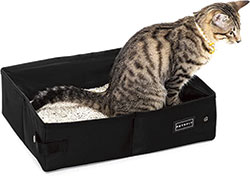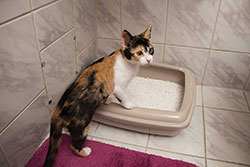Elimination problems are the most common complaint among cat guardians, and a leading reason why owners give up their cats to animal shelters. While the underlying reasons driving cats to engage in what’s known clinically as “feline inappropriate elimination” are complex and varied, there are three categories that it typically falls into:
· Medical problems
· Marking
· Toileting problems
The first step if your cat eliminates outside the box is to make an appointment with your veterinarian. Urinary tract infections, hyperthyroidism, kidney disease and diabetes are just some of the health problems that may underlie litterbox problems in cats. Often cats are not seen for regular wellness visits so if it’s been a while since your kitty has been seen your vet is the first place you should go. Once these are ruled out, and your pet is otherwise healthy, you’ll need to start looking into the other common reasons that compel cats to do their business outside of the box.
Calm Your Kitty!
Your cat naps whenever they want, gets catered meals multiple times a day and has their pick of toys what’s there to stress about, right? Your cat may see it differently. Changes in routine, even minor things like moving furniture or you taking out luggage to pack for an upcoming trip living with other pets, visitors in the home and loud noises, ranging from yelling and music to thunderstorms and fireworks, can be anxiety-inducing for cats.
Research even shows that hair and nail cortisol concentrations are significantly increased in cats with litterbox issues compared to those without. Since cortisol is used as an indicator of stress, it’s possible that calming your cat could solve the litterbox problems.
Urine marking, when it takes the form of spraying, may also be related to stress, and you can get clues based on where the marking occurs. Generally speaking:
If he marks under windows or on baseboards, he may perceive a threat from animals outside, usually other cats
If he marks on or near furniture or doors inside your home, he might be having problems with other cats in the household.
If your cat marks personal belongings, such as clothes, bed linens, a favorite chair or a computer keyboard, he could be experiencing some anxiety about the human who owns those things.
To successfully address stress, you must identify the source and strive to resolve it. While you are working on resolving possible stressors, I recommend adding in some natural stress support. Flower Essences, such as Solutions, are safe for cats. Feliway (also known as comfort zone) pheromone spray and homeopathic remedies for specific symptoms can also be beneficial.
Solve Litterbox Aversion
Does your cat hop into the litterbox, scratch around, do their business, cover it up, then hop out? This is a sign that all is well in your cat’s toileting life, and you can leave well enough alone.
If, however, your cat jumps in the box and quickly gets out, eliminates while perched on the edge of the box or will only put two paws in, there’s a good chance they don’t like something about the set up. This is particularly true if they’re also eliminating next to, but not in, the box.
It’s up to you to discover what your cat disapproves of. It could be related to the litter itself. Granule size, depth of litter or type; or due to the litterbox not being cleaned often enough. The litterbox may also be to blame, depending on whether your cat prefers covered or uncovered, smaller or larger boxes, lined or unlined or dislikes a self-cleaning box, for instance.
The location of the litterbox also matters a lot! Is it in a noisy location? Approachable by dogs? Used by multiple cats? Any or all of these could be the reason why your cat is choosing to eliminate elsewhere.
You can discover your kitty’s litter preference by buying the smallest amount available of several kinds of litter, and several inexpensive litterboxes. Place the boxes with different litters side by side and see which box gets used most often. Once you know the type of litter your cat prefers, be sure it’s deep enough in the box (4 inches is recommended). It’s surprising how particular some cats are about texture, and smell of litter. Then again cats actually have a better sense of smell than our canine friends.
You’ll also want to clean the litterbox fastidiously, scooping twice a day and doing a deep cleaning, including changing out all of the used the litter for fresh litter. For non-clumping don’t wait longer than a week and for products that say they last a long time don’t go longer than two weeks for a box change. The box should be cleaned with hot water and fragrance-free natural soap regularly. Avoid fragranced products and replace plastic litterboxes every year or two.
If you have multiple cats, you may need to add more boxes. The general guideline is one box per cat, and one extra. Also be sure that the box is easily accessible, ideally with at least one low spot for your cat to step in, especially if they’re older.
If there’s a spot where your cat is persistently eliminating in, you can also try placing the litterbox there, then very gradually moving it to a location that you prefer just make sure it’s a quiet, private location that your cat won’t mind using.
Get Rid of Old Accidents
The scent of past “accidents” can draw your cat back to them, causing them to eliminate there all over again. You’ll want to identify all areas that have been soiled (use a black light if necessary, cat urine glows brightly underneath one) and clean them thoroughly.
Saturate the spot with a commercially available enzyme-based “digester” solution and let it sit for the prescribed amount of time. Thoroughly saturate the soiled areas, including carpet padding, if you suspect the urine has soaked all the way through and let it dry completely before any shampooing.
If the urine spot has been there awhile, you may need to repeat the process and, depending on the scope of the problem, be prepared to make this a multiweek project as you soak the spots, blot them, allow them to dry and then repeat the process as many times as necessary to completely remove stains and odor.
With persistence and patience, however, most cases of inappropriate elimination can be remedied. Don’t give up on your cat! Experiment with different solutions and litterbox options until you find the combination that best suits your cat’s needs.

|